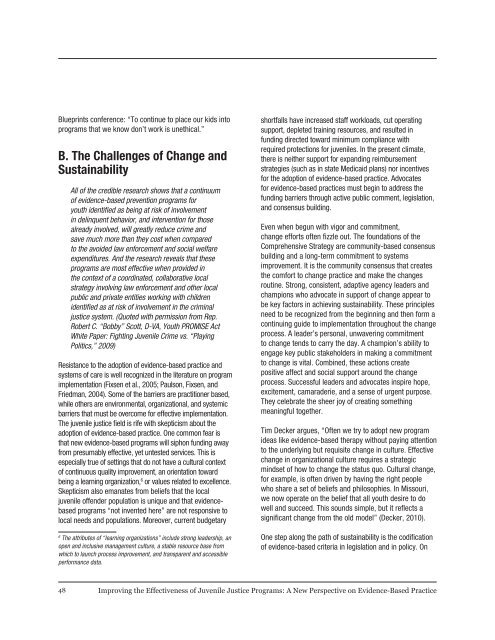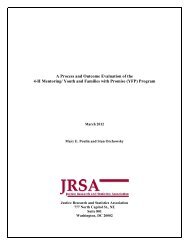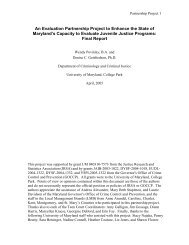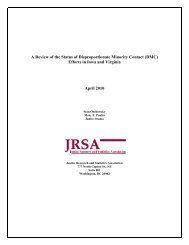Improving the Effectiveness of Juvenile Justice Programs: A New
Improving the Effectiveness of Juvenile Justice Programs: A New
Improving the Effectiveness of Juvenile Justice Programs: A New
Create successful ePaper yourself
Turn your PDF publications into a flip-book with our unique Google optimized e-Paper software.
Blueprints conference: “To continue to place our kids into<br />
programs that we know don’t work is unethical.”<br />
B. The Challenges <strong>of</strong> Change and<br />
Sustainability<br />
All <strong>of</strong> <strong>the</strong> credible research shows that a continuum<br />
<strong>of</strong> evidence-based prevention programs for<br />
youth identified as being at risk <strong>of</strong> involvement<br />
in delinquent behavior, and intervention for those<br />
already involved, will greatly reduce crime and<br />
save much more than <strong>the</strong>y cost when compared<br />
to <strong>the</strong> avoided law enforcement and social welfare<br />
expenditures. And <strong>the</strong> research reveals that <strong>the</strong>se<br />
programs are most effective when provided in<br />
<strong>the</strong> context <strong>of</strong> a coordinated, collaborative local<br />
strategy involving law enforcement and o<strong>the</strong>r local<br />
public and private entities working with children<br />
identified as at risk <strong>of</strong> involvement in <strong>the</strong> criminal<br />
justice system. (Quoted with permission from Rep.<br />
Robert C. “Bobby” Scott, D-VA, Youth PROMISE Act<br />
White Paper: Fighting <strong>Juvenile</strong> Crime vs. “Playing<br />
Politics,” 2009)<br />
Resistance to <strong>the</strong> adoption <strong>of</strong> evidence-based practice and<br />
systems <strong>of</strong> care is well recognized in <strong>the</strong> literature on program<br />
implementation (Fixsen et al., 2005; Paulson, Fixsen, and<br />
Friedman, 2004). Some <strong>of</strong> <strong>the</strong> barriers are practitioner based,<br />
while o<strong>the</strong>rs are environmental, organizational, and systemic<br />
barriers that must be overcome for effective implementation.<br />
The juvenile justice field is rife with skepticism about <strong>the</strong><br />
adoption <strong>of</strong> evidence-based practice. One common fear is<br />
that new evidence-based programs will siphon funding away<br />
from presumably effective, yet untested services. This is<br />
especially true <strong>of</strong> settings that do not have a cultural context<br />
<strong>of</strong> continuous quality improvement, an orientation toward<br />
being a learning organization, 6 or values related to excellence.<br />
Skepticism also emanates from beliefs that <strong>the</strong> local<br />
juvenile <strong>of</strong>fender population is unique and that evidencebased<br />
programs “not invented here” are not responsive to<br />
local needs and populations. Moreover, current budgetary<br />
6<br />
The attributes <strong>of</strong> “learning organizations” include strong leadership, an<br />
open and inclusive management culture, a stable resource base from<br />
which to launch process improvement, and transparent and accessible<br />
performance data.<br />
shortfalls have increased staff workloads, cut operating<br />
support, depleted training resources, and resulted in<br />
funding directed toward minimum compliance with<br />
required protections for juveniles. In <strong>the</strong> present climate,<br />
<strong>the</strong>re is nei<strong>the</strong>r support for expanding reimbursement<br />
strategies (such as in state Medicaid plans) nor incentives<br />
for <strong>the</strong> adoption <strong>of</strong> evidence-based practice. Advocates<br />
for evidence-based practices must begin to address <strong>the</strong><br />
funding barriers through active public comment, legislation,<br />
and consensus building.<br />
Even when begun with vigor and commitment,<br />
change efforts <strong>of</strong>ten fizzle out. The foundations <strong>of</strong> <strong>the</strong><br />
Comprehensive Strategy are community-based consensus<br />
building and a long-term commitment to systems<br />
improvement. It is <strong>the</strong> community consensus that creates<br />
<strong>the</strong> comfort to change practice and make <strong>the</strong> changes<br />
routine. Strong, consistent, adaptive agency leaders and<br />
champions who advocate in support <strong>of</strong> change appear to<br />
be key factors in achieving sustainability. These principles<br />
need to be recognized from <strong>the</strong> beginning and <strong>the</strong>n form a<br />
continuing guide to implementation throughout <strong>the</strong> change<br />
process. A leader’s personal, unwavering commitment<br />
to change tends to carry <strong>the</strong> day. A champion’s ability to<br />
engage key public stakeholders in making a commitment<br />
to change is vital. Combined, <strong>the</strong>se actions create<br />
positive affect and social support around <strong>the</strong> change<br />
process. Successful leaders and advocates inspire hope,<br />
excitement, camaraderie, and a sense <strong>of</strong> urgent purpose.<br />
They celebrate <strong>the</strong> sheer joy <strong>of</strong> creating something<br />
meaningful toge<strong>the</strong>r.<br />
Tim Decker argues, “Often we try to adopt new program<br />
ideas like evidence-based <strong>the</strong>rapy without paying attention<br />
to <strong>the</strong> underlying but requisite change in culture. Effective<br />
change in organizational culture requires a strategic<br />
mindset <strong>of</strong> how to change <strong>the</strong> status quo. Cultural change,<br />
for example, is <strong>of</strong>ten driven by having <strong>the</strong> right people<br />
who share a set <strong>of</strong> beliefs and philosophies. In Missouri,<br />
we now operate on <strong>the</strong> belief that all youth desire to do<br />
well and succeed. This sounds simple, but it reflects a<br />
significant change from <strong>the</strong> old model” (Decker, 2010).<br />
One step along <strong>the</strong> path <strong>of</strong> sustainability is <strong>the</strong> codification<br />
<strong>of</strong> evidence-based criteria in legislation and in policy. On<br />
48 <strong>Improving</strong> <strong>the</strong> <strong>Effectiveness</strong> <strong>of</strong> <strong>Juvenile</strong> <strong>Justice</strong> <strong>Programs</strong>: A <strong>New</strong> Perspective on Evidence-Based Practice

















